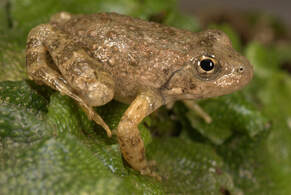
doi: https://doi.org/10.1002/ecs2.4645
 A new study published in the journal Ecosphere has identified key environmental factors that influence the population dynamics of the Foothill Yellow-legged Frog (Rana boylii), a stream-breeding amphibian native to California and Oregon. The study, which was conducted by researchers from the U.S. Geological Survey, the University of California, Berkeley, and other institutions, is the first to jointly analyze abundance data from populations throughout the frog’s range. The study found that population growth of the Foothill Yellow-legged Frog was positively related to stream temperature and was higher in the years following a wet year with high total annual streamflow. Density dependence, which is the tendency for population growth to slow down as populations approach carrying capacity, was weakest (i.e., carrying capacity was highest) for streams with high seasonality of streamflow and intermediate rates of change in streamflow during spring. These results highlight how altered streamflow can further increase the risk of decline for Foothill Yellow-legged Frog populations. Managing stream conditions to better match natural flow and thermal regimes would benefit the conservation of Foothill Yellow-legged Frog populations. The Foothill Yellow-legged Frog has experienced significant declines throughout its range, and is considered a threatened species under the California Endangered Species Act. The study’s findings provide important information for the conservation of this species, and can be used to guide management practices that aim to restore and protect stream habitats. Citation: Rose, J. P., S. J. Kupferberg, R. A. Peek, D. Ashton, J. B. Bettaso, S. Bobzien, R. M. Bourque, K. G.H. Breedveld, A. Catenazzi, J. E. Drennan, E. Gonsolin, M. Grefsrud, A. E. Herman, M. R. House, M. R. Kluber, A. J. Lind, K. R. Marlow, A. Striegle, M. van Hattem, C. A. Wheeler, J. T. Wilcox, K. D. Wiseman, B. J. Halstead. 2023. Identifying drivers of population dynamics for an imperiled stream breeding amphibian using time series of egg mass counts. Ecosphere 14: e4645.
doi: https://doi.org/10.1002/ecs2.4645
0 Comments
Leave a Reply. |
Archives
June 2024
CATENAZZI LABNews from the lab Categories |